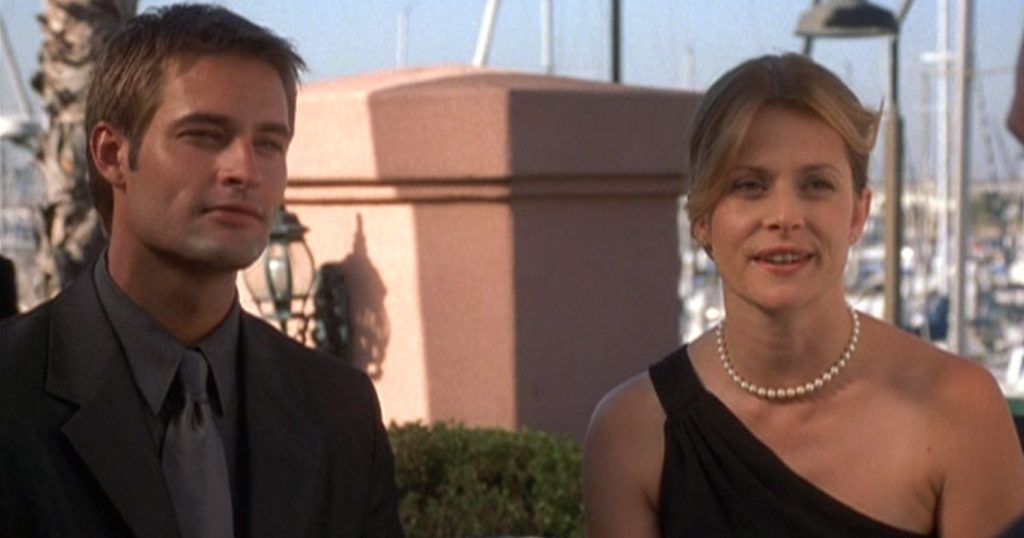Dir: Steve Boyum
Star: Susie Amy, Michael York, Gérard Depardieu, Nastassja Kinski
a.k.a. La Femme Musketeer
I once made the mistake of trying to read the original Three Musketeers novel. Let’s just say, it quickly became clear that Alexandre Dumas was getting paid by the word for his story. I didn’t finish it. The various films magde, I’ve generally enjoyed a lot more, particularly the seventies version, which also starred York, the nineties one with Kiefer Sutherland, and even the 2011 adaptation directed by the guy who did Resident Evil. This is fine as well, being a cheerful romp that was originally a Hallmark mini-series. It’s partly a reboot, partly a sequel, and partly a re-imagining, yet manages to pull the disparate elements together and ends up being an entertaining 171 minutes.
The heroine is Valentine D’Artagnan (Amy), daughter of the renowned Musketeer (York), who has retired to the country and lives a quiet life. Valentine has bigger dreams, as well as all the swordsmanship (or swordswomanship) skills her father can teach, and heads off to Paris with a letter of recommendation. Meanwhile, the shenanigans around the court continue as they did in Dad’s time. Now, it’s young king Louis XIV on the throne, with the conspiring Cardinal Mazarin (Depardieu) seeking to exercise control over the king, courtesy of a letter which casts doubt on the monarch’s parentage, and thus, legitimacy.
This is where Nastassja comes in, for she plays the Cardinal’s top spy, Lady Bolton, who succeeded in obtaining the letter from an English noble, the Duke of Buckingham. However, making her way towards Paris is Maria Theresa of Spain: if she gets there safely, and weds the king, all Mazarin’s plans go up in smoke, and it will also end the war between France and Spain. He sends his forces out to make sure Theresa never arrives. Tasked with ensuring she does, are three young Musketeers (who just happen to be the sons of famous fathers), along with Valentine, who is falsely accused of murder by Lady Bolton, after the king’s mistress discovers the letter as well as its contests, and needs to be silenced by Bolton (as shown at top).
It’s interesting to see this sitting next in her filmography to Kinski’s performance in a sixties update of Dangerous Liaisons. For I sense that Lady Bolton would have got on quite well with the Marquise de Merteuil, both being big fans of intrigue, deceit and plotting. Though Bolton is likely a better hand with a throwing knife, shall we say, and is more interested in politics than personal vendettas. She’s perhaps not quite as memorable as Faye Dunaway in the seventies Three Musketeers, who played the equivalent character of Milady de Winter. But it’s likely more in line with the cast here, which is not as stellar as its predecessor. Though in its defense, this wisely isn’t trying to be.
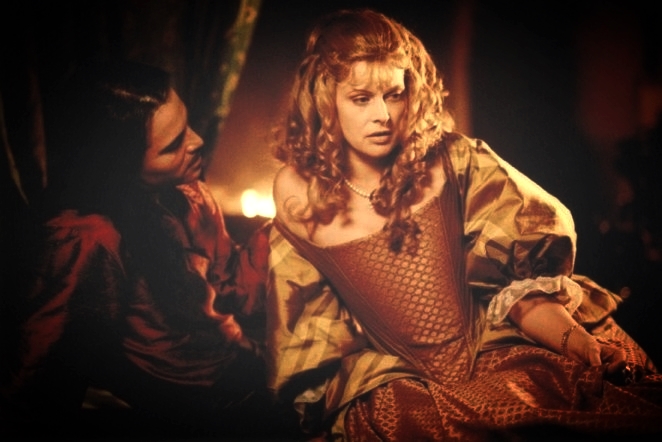
There is still good entertainment here. I loved the way the original trio of musketeers (including John Rhys-Davis from Lord of the Rings, as Porthos) have become a theatrical troupe, touring the country to re-enact their adventures for the locals. Also how they end up rescuing two of their sons from an unfortunate, noose-shaped situation: I’d have been quite happy if this had been the film’s main narrative, as was done in The Return of the Musketeers. But it’s only one element: as you can imagine from the above, and its almost entire separation from the plot described earlier, there are a lot of moving parts to the storyline. This is where the extended running time works in the movie’s favor: the various facets get a chance to breathe, rather than feeling crammed in.
It does have hints of a Europudding recipe here, illustrated by Kinski’s role: she’s a German actress, playing a character with an English name, hanging round the French court. Meanwhile, Amy’s accent as the heroine is less South of France, and more Sarf London, though it… drifts in and out considerably, shall we say, over the course of proceedings. The main problem is likely the blandness of the younger actors. Amy is by no means the worst offender here though: Valentine is a feisty enough character to be fun, even if the concept here requires credibility stretching at epic levels. No, the dishonors here go to the next generation of the three musketeers, who are utterly forgettable, especially when compared to veterans like York, Rhys-Davis, Depardieu and Kinski.
Filmed largely in Croatia (another slice of Europudding?), the makers get good bang for their buck, with the country providing some convincing historical locations. The pretty scenery is shot attractively by veteran cinematographer David Connell, but unfortunately, he seems much less adept at capturing the action. I mean, you’re basically doing The 3 Musketeers. There is going to be copious quantities of swordplay. Swashes will be buckled here. But in general, the fights fell victim to the curse of modern action movies, being shot too close and edited too fast. This might make sense when you’ve got Michael York, then well into his sixties and likely requiring a stunt-double for some action. But the younger versions? Get people who can handle a sword, sit the camera back a bit, and let the viewer appreciate it.
All told, however, I can’t complain much, if at all. It’s a concept which is clearly intended purely for entertainment, and this renders spurious most complaints about historical inaccuracy. Especially when they are as pedantic as one review I read, which complained that the English nobility were wearing, “The court fashions of at least ten years later.” I feel safe in assuming that most viewers of a Hallmark channel TVM, will have limited expertise in the area of 17th century clothing, and thus gaffes in this department are unlikely to impact enjoyment of the production to any significant degree. Those of us less inclined to obsess over such things should have fun with this ripping yarn. As an indication of its merits, even if a relatively small part for her, this is one of the very few Kinski-made-for-television entries which I’ve actually retained on DVD.
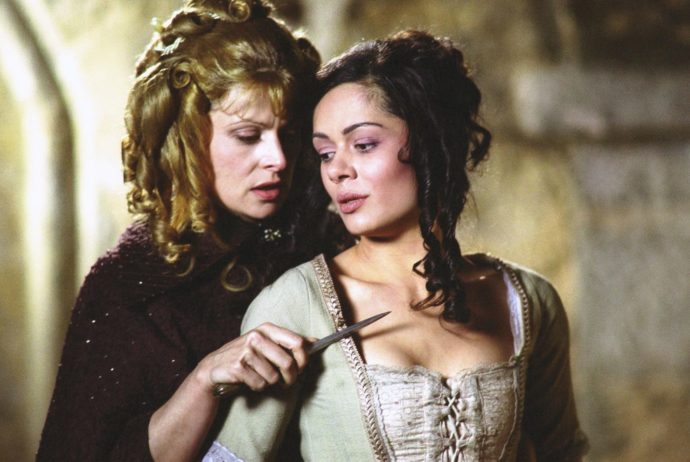

 The change in setting works perfectly well. It’s a story that is easily adaptable to any time and place where there are the “idle rich” – those with nothing better to do than play vicious games with other people. Technically, the production design is well above what you might expect from the phrase “TV miniseries”. It looks luscious: Jean-Paul Gaultier was involved in the costume design for the Marquise de Merteuil, and it’s likely also heaven for fans of classic cars. It sounds pretty damn good too. Frequent David Lynch collaborator Angelo Badalamenti provides the music, some cues in which reminded me of Jerry Goldsmith’s ominous yet melodious score for Basic Instinct.
The change in setting works perfectly well. It’s a story that is easily adaptable to any time and place where there are the “idle rich” – those with nothing better to do than play vicious games with other people. Technically, the production design is well above what you might expect from the phrase “TV miniseries”. It looks luscious: Jean-Paul Gaultier was involved in the costume design for the Marquise de Merteuil, and it’s likely also heaven for fans of classic cars. It sounds pretty damn good too. Frequent David Lynch collaborator Angelo Badalamenti provides the music, some cues in which reminded me of Jerry Goldsmith’s ominous yet melodious score for Basic Instinct.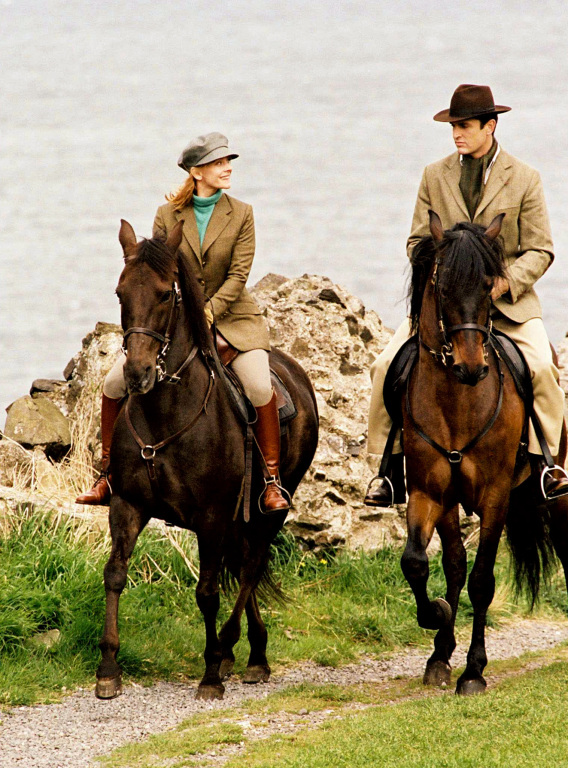 Deneuve does rather better, displaying icy control throughout: that she still falls somewhat short, is less indicative of her own shortcomings, than the monumental awesomeness which was Glenn Close. I may be biased with the Pfeiffer comparison, but I found Kinski’s portrayal as the principled – to the point of saintly – Marie de Tourvel fractionally superior. This is a character which has to be
Deneuve does rather better, displaying icy control throughout: that she still falls somewhat short, is less indicative of her own shortcomings, than the monumental awesomeness which was Glenn Close. I may be biased with the Pfeiffer comparison, but I found Kinski’s portrayal as the principled – to the point of saintly – Marie de Tourvel fractionally superior. This is a character which has to be 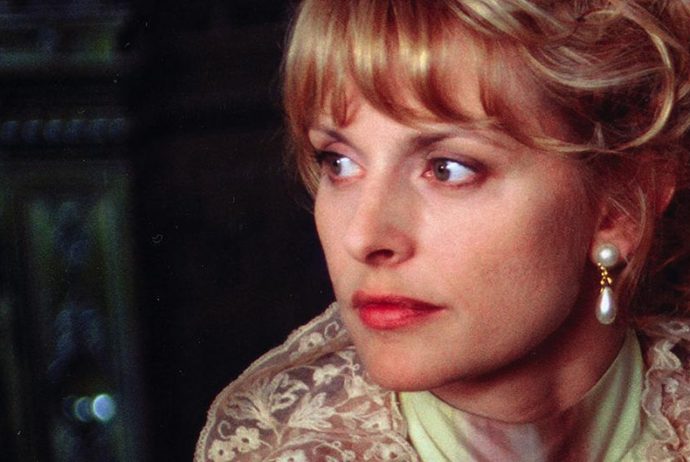

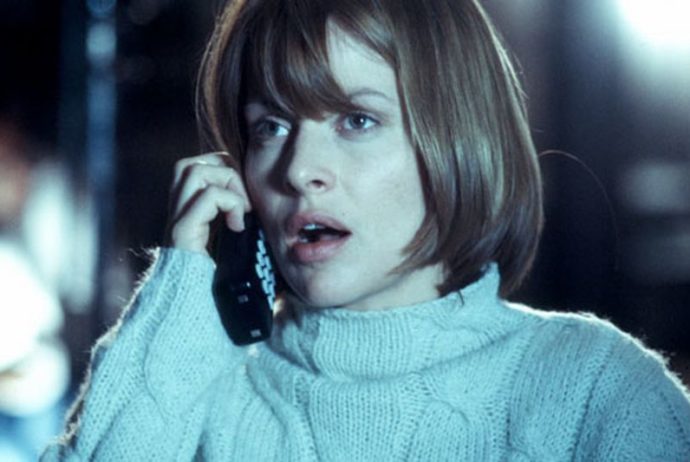
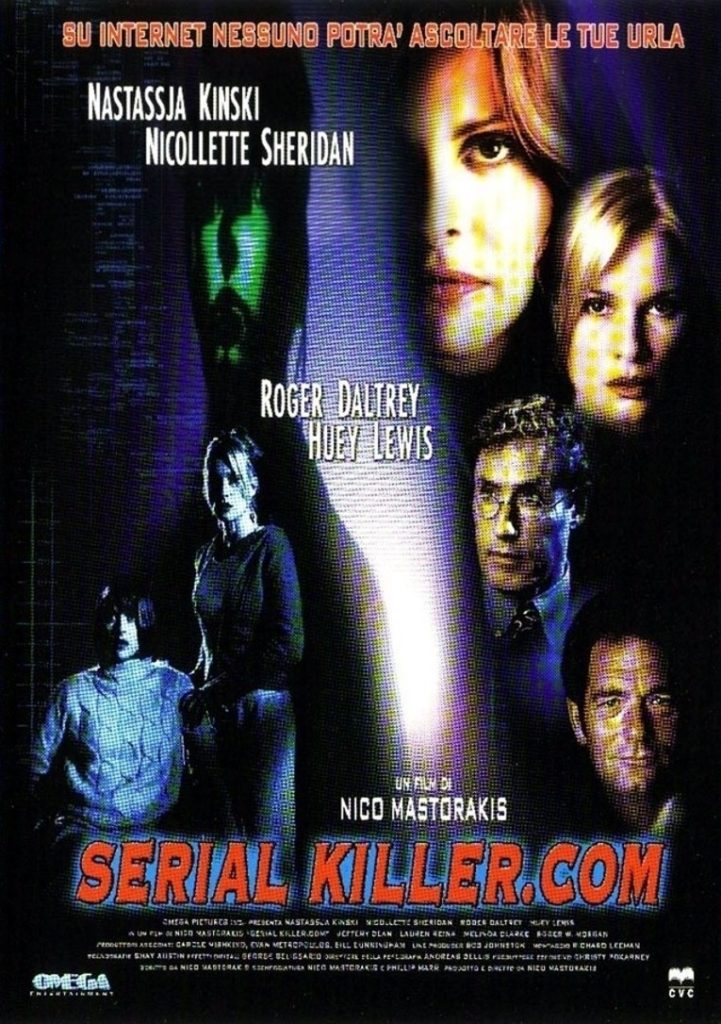 Things do not improve once you get past this. Sondra, in a wheelchair after some leg-injuring incident that is never explained, is left alone to occupy her hi-tech, voice-activated house, when her husband, Ben (Roger Daltrey, for some inexplicable reason – if you’ve read this far, you’ll know this isn’t even the most questionable rock star cast in the film) goes off on a business trip. Poking around his computer, she guesses his password and discovers Ben has been cheating on her in cyberspace. She goes into the same room, meets his virtual mistress, but also gets into a flame war with some troll, who decides to show her who’s boss, by killing the mistress and sending Sondra a video of the event.
Things do not improve once you get past this. Sondra, in a wheelchair after some leg-injuring incident that is never explained, is left alone to occupy her hi-tech, voice-activated house, when her husband, Ben (Roger Daltrey, for some inexplicable reason – if you’ve read this far, you’ll know this isn’t even the most questionable rock star cast in the film) goes off on a business trip. Poking around his computer, she guesses his password and discovers Ben has been cheating on her in cyberspace. She goes into the same room, meets his virtual mistress, but also gets into a flame war with some troll, who decides to show her who’s boss, by killing the mistress and sending Sondra a video of the event.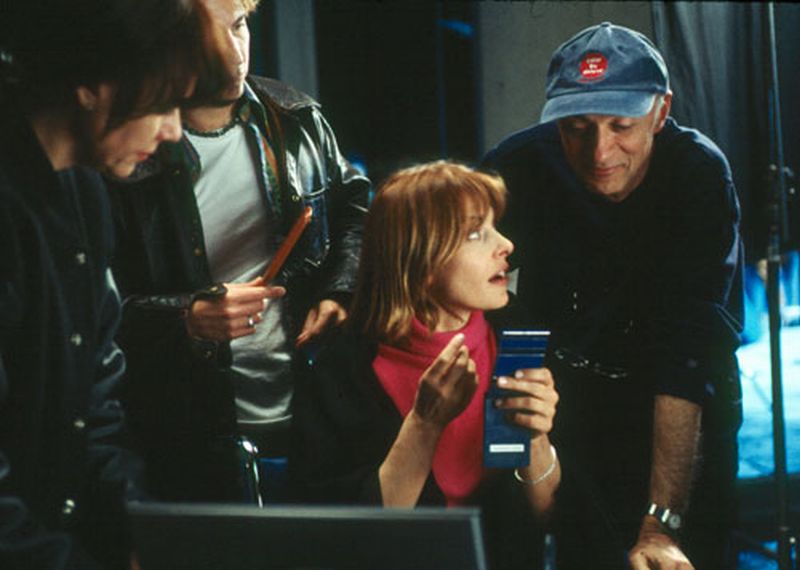 I lost track of the number of occasions I realized I had given up paying attention at all to the film, and had to rewind it back to where I had drifted off. Probably eight or nine, at least. About the only scene that makes any impact is one where Matheson is speaking to another agent, and she does a surprisingly accurate description of what would, a few years down the line, be known broadly as the Dark Web. Everywhere else, the film propagates a depiction of technology which is about on a par with the depiction of marijuana found in Reefer Madness. Oh, and B-movie queen Julie Strain turns up briefly as an exotic dancer. She may be the only cast member who should not be embarrassed by this.
I lost track of the number of occasions I realized I had given up paying attention at all to the film, and had to rewind it back to where I had drifted off. Probably eight or nine, at least. About the only scene that makes any impact is one where Matheson is speaking to another agent, and she does a surprisingly accurate description of what would, a few years down the line, be known broadly as the Dark Web. Everywhere else, the film propagates a depiction of technology which is about on a par with the depiction of marijuana found in Reefer Madness. Oh, and B-movie queen Julie Strain turns up briefly as an exotic dancer. She may be the only cast member who should not be embarrassed by this.
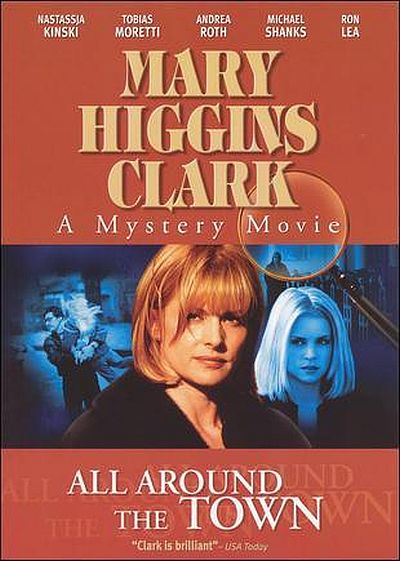 This proves a problem with regard to her English teacher, Alan Grant, who is receiving hot and steamy letters from a mysterious unknown woman – much to the chagrin of his wife, Karen (Kinski). Alan eventually realizes the handwriting is a match for Laurie, but when confronted, she angrily denies it, in an argument that draws too much public attention. Which is unfortunate, because the next day, the teacher turns up stabbed to death, with a knife taken from the Kinmount house, and Laurie has no memory of what happened. For it turns out her psyche has reacted to the trauma of the abduction by splintering into multiple personalities. One, Debbie, is based on her four-year-old self, another, Kate, is a super protective persona inspired by her mother… and as Margaret Cho once said, then there’s the ho, Leona. Guess which one was writing the notes, and lurking outside Alan’s window?
This proves a problem with regard to her English teacher, Alan Grant, who is receiving hot and steamy letters from a mysterious unknown woman – much to the chagrin of his wife, Karen (Kinski). Alan eventually realizes the handwriting is a match for Laurie, but when confronted, she angrily denies it, in an argument that draws too much public attention. Which is unfortunate, because the next day, the teacher turns up stabbed to death, with a knife taken from the Kinmount house, and Laurie has no memory of what happened. For it turns out her psyche has reacted to the trauma of the abduction by splintering into multiple personalities. One, Debbie, is based on her four-year-old self, another, Kate, is a super protective persona inspired by her mother… and as Margaret Cho once said, then there’s the ho, Leona. Guess which one was writing the notes, and lurking outside Alan’s window?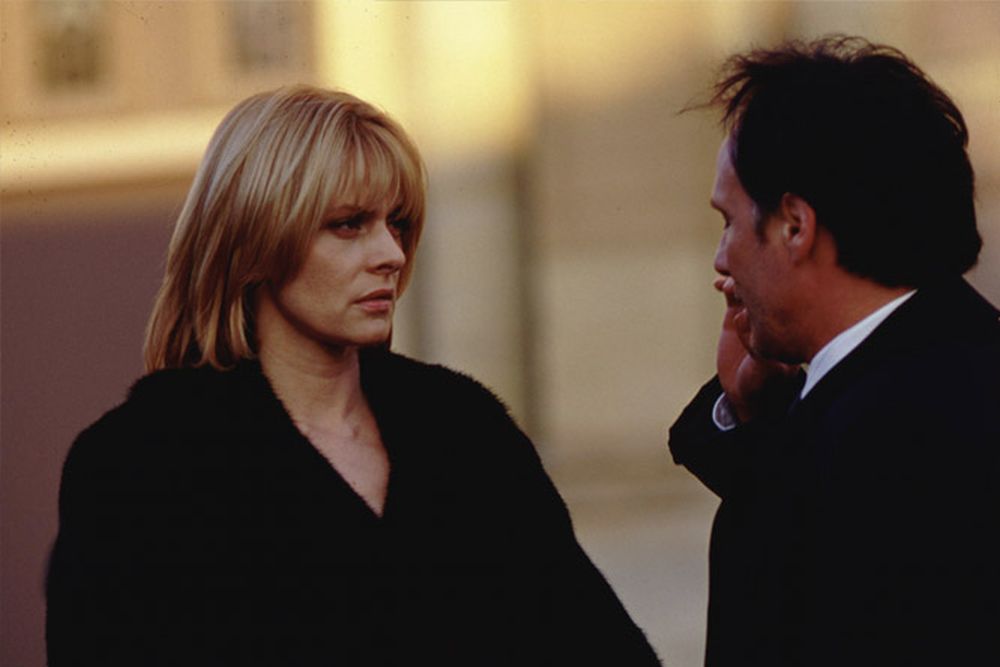
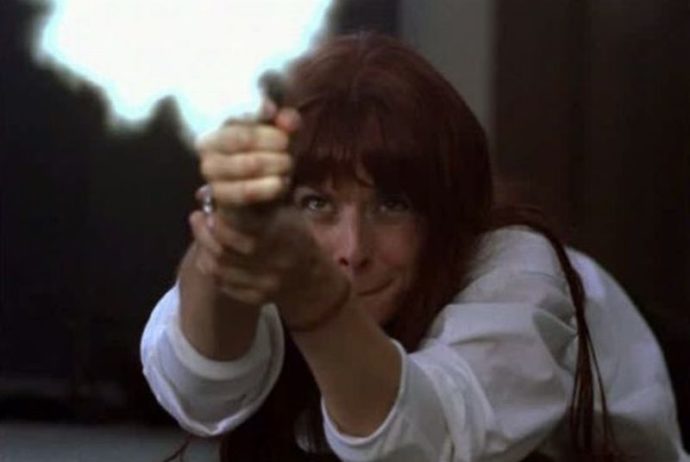
 Structurally, it’s a mess. The opening scene makes it seem that Jack is going to be the focus of the movie, since it opens with him being chased naked through the streets by the cops. Then the movie shifts into a flashback, and he vanishes almost entirely for the rest of the first half. Thereafter, the film thrashes around, between Lexi, Misha and Helena, unable to settle on providing any one of them with particular depth. It’s never even explained, in any convincing way, why even the least picky of women would want to be in the same room as Sergei, let alone have a relationship with him. [And McCardie, from Glasgow, makes a thoroughly unconvincing Russian – at least Denisof has some appropriate ancestry on his father’s side, though I’m not sure his accent is any better for it]
Structurally, it’s a mess. The opening scene makes it seem that Jack is going to be the focus of the movie, since it opens with him being chased naked through the streets by the cops. Then the movie shifts into a flashback, and he vanishes almost entirely for the rest of the first half. Thereafter, the film thrashes around, between Lexi, Misha and Helena, unable to settle on providing any one of them with particular depth. It’s never even explained, in any convincing way, why even the least picky of women would want to be in the same room as Sergei, let alone have a relationship with him. [And McCardie, from Glasgow, makes a thoroughly unconvincing Russian – at least Denisof has some appropriate ancestry on his father’s side, though I’m not sure his accent is any better for it]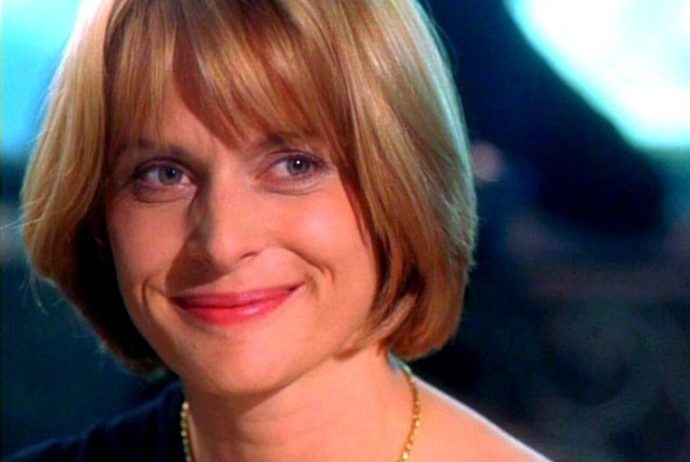
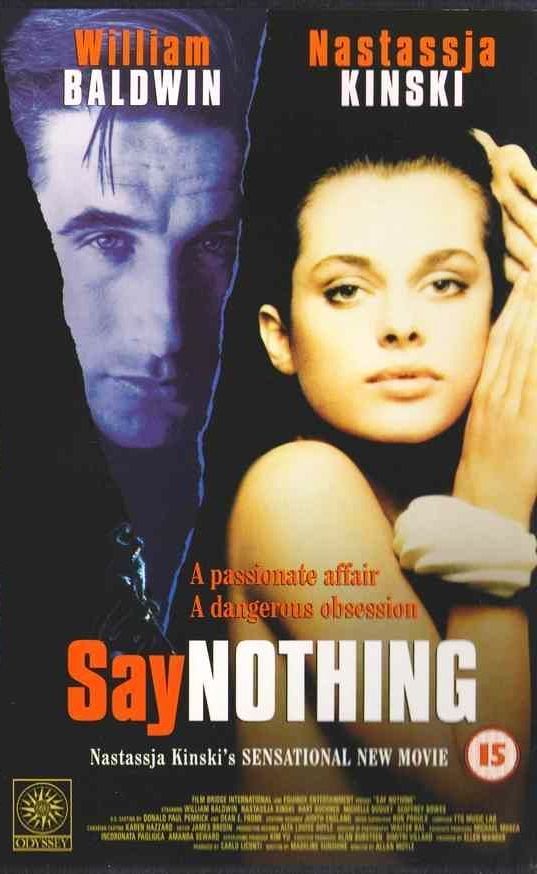 Moving rapidly away from politics, the target for Julian Grant (Baldwin) is Grace Needham (Kinski), whose marriage is currently on shaky grounds. Her husband, Matt (Bochner) lost his job, went into a downward spiral and now sits around the house, drinking. Even when friends give them a vacation to Miami Beach, he refuses to go, so Grace takes the trip by herself. Which is where she meets Julian, who is also at the resort by himself. After a little dining and sailing, they have a briefly passionate encounter on the beach, which Grace immediately regrets. Returning to her home, she’s convinced the best solution is to follow the title’s advice, especially since things seem to be improving again, with Matt finding a great job. However, she’s dismayed when she realizes that his new boss, and the man responsible for her husband’s position, is Julian. For he’s not prepared to regard what happened as a one-night stand, and will stop at nothing to pursue Grace.
Moving rapidly away from politics, the target for Julian Grant (Baldwin) is Grace Needham (Kinski), whose marriage is currently on shaky grounds. Her husband, Matt (Bochner) lost his job, went into a downward spiral and now sits around the house, drinking. Even when friends give them a vacation to Miami Beach, he refuses to go, so Grace takes the trip by herself. Which is where she meets Julian, who is also at the resort by himself. After a little dining and sailing, they have a briefly passionate encounter on the beach, which Grace immediately regrets. Returning to her home, she’s convinced the best solution is to follow the title’s advice, especially since things seem to be improving again, with Matt finding a great job. However, she’s dismayed when she realizes that his new boss, and the man responsible for her husband’s position, is Julian. For he’s not prepared to regard what happened as a one-night stand, and will stop at nothing to pursue Grace.
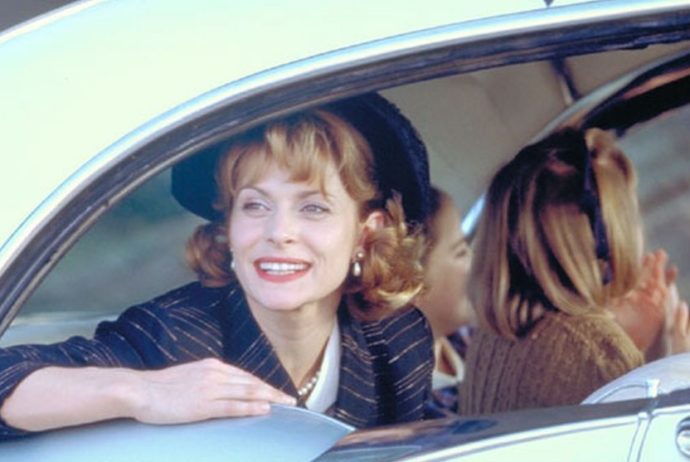
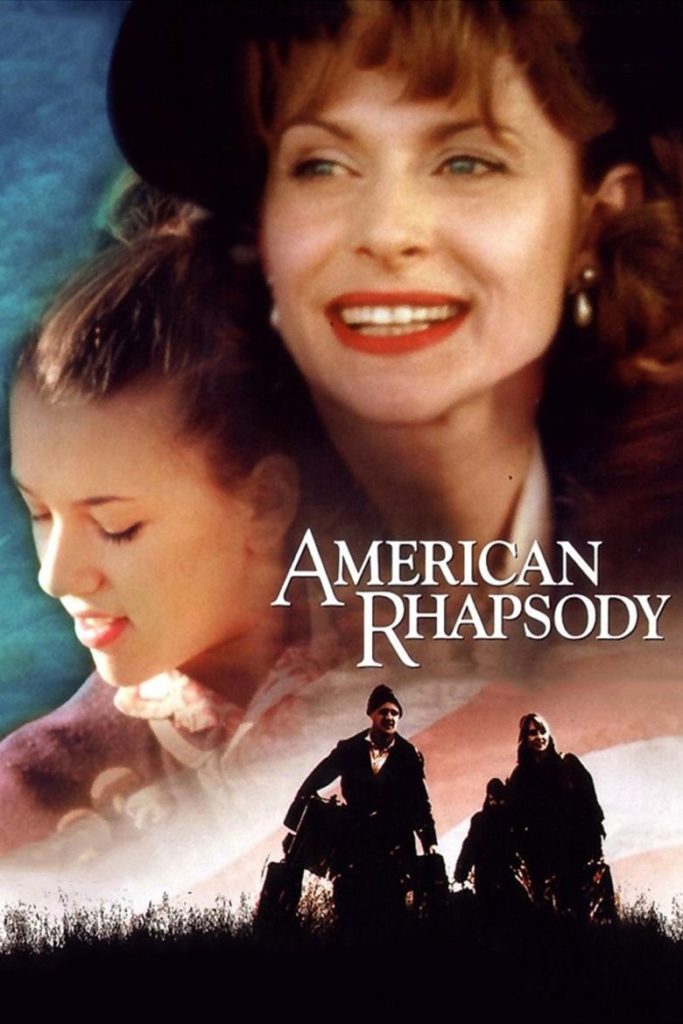 Eventually, her more level-headed father agrees to let Suzanne return to Hungary, and visit her foster family. While delighted to see her, they are now living in a Budapest apartment, and Suzanne gets to experience first-hand the failures of Communism. However, she also discovers the specific reason why her mother was unable to live in the country any longer, and gains a new-found appreciation for what her parents went through in order to give her a better life. So, it all ends in hugs between mother and daughter, because America is the bestest country in the world ever, am I right?
Eventually, her more level-headed father agrees to let Suzanne return to Hungary, and visit her foster family. While delighted to see her, they are now living in a Budapest apartment, and Suzanne gets to experience first-hand the failures of Communism. However, she also discovers the specific reason why her mother was unable to live in the country any longer, and gains a new-found appreciation for what her parents went through in order to give her a better life. So, it all ends in hugs between mother and daughter, because America is the bestest country in the world ever, am I right?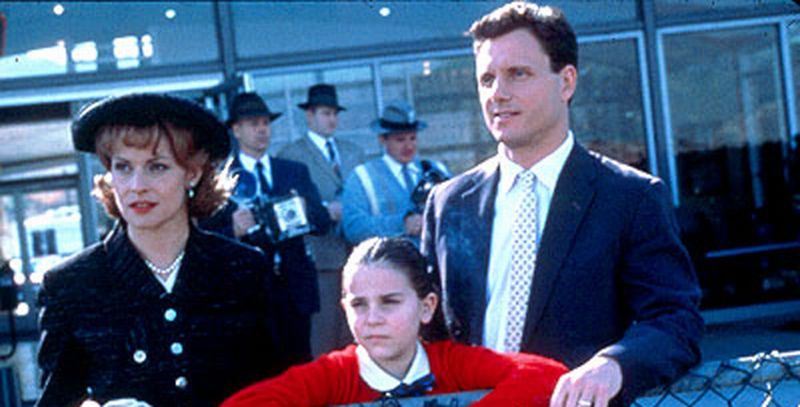
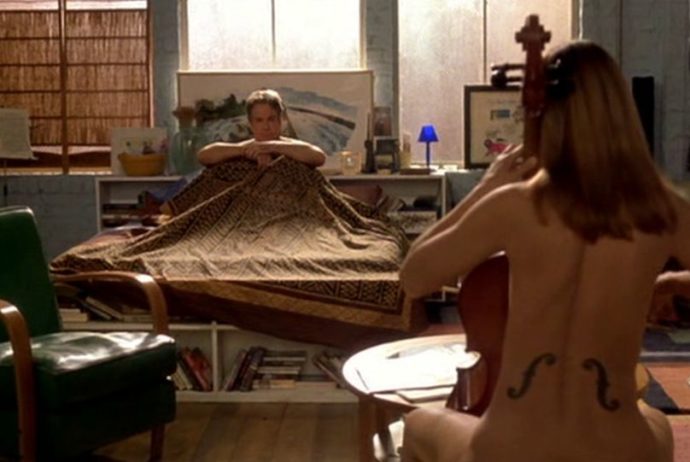
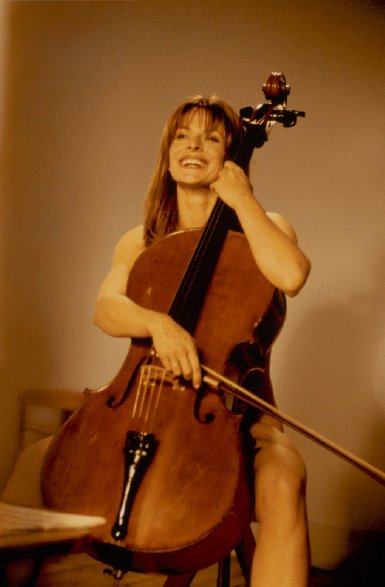 If you’re thinking this sounds tedious, you are right on the mark and I am doing my job with the apathetic synopsis above. For this is one of those cases where the production was rather more interesting that the film itself. Even before it came out, the film
If you’re thinking this sounds tedious, you are right on the mark and I am doing my job with the apathetic synopsis above. For this is one of those cases where the production was rather more interesting that the film itself. Even before it came out, the film 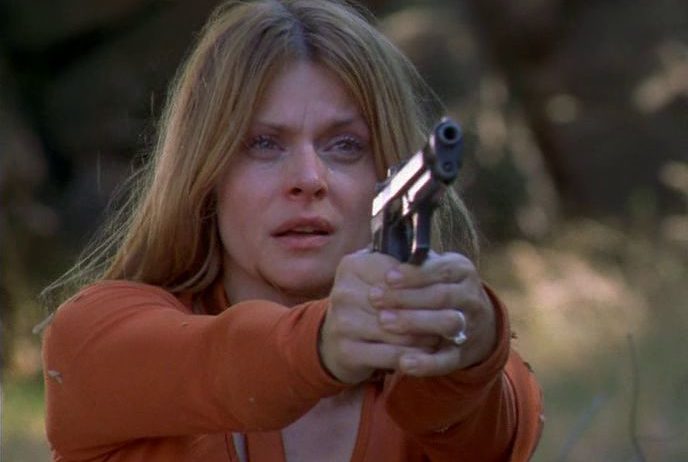
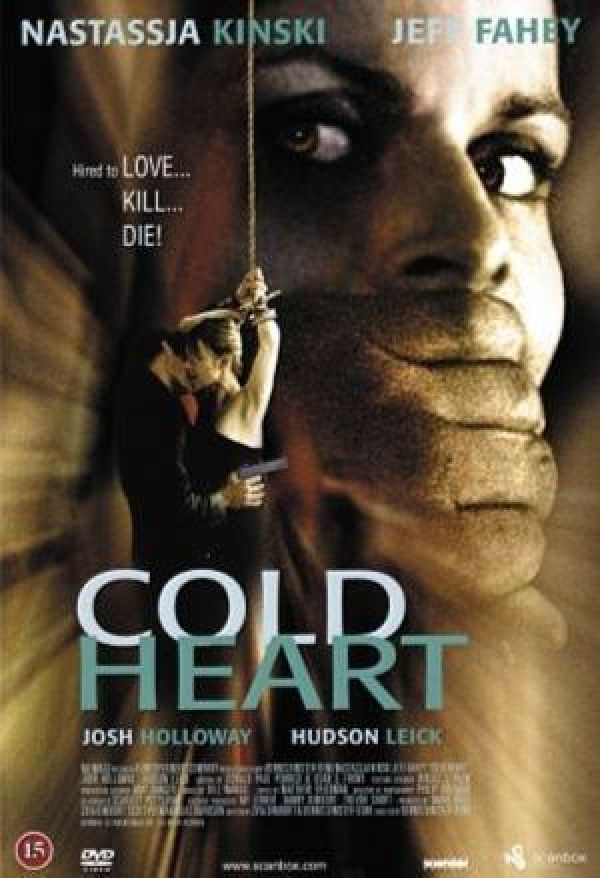 Here, I’ll also mention there are two types of movie psychopaths. Type A are the creepy ones, about whom you can immediately tell something is wrong immediately: the Norman Bateses. Then there is Type B, the suave and charismatic manipulators: the Patrick Batemans. It’s the latter category into which Sean falls. And, hey whaddya know. he immediately ends up working for Dr. Cross’s wife, Linda (Kinski), who runs a movie production company. For what are the odds that he would casually run into her partner, Julia (Leick) at a coffee-stand and charm her into offering him a job? Actually, if you’ve seen many of this kind of thriller, you’ll know the answer is, “about 100%”.
Here, I’ll also mention there are two types of movie psychopaths. Type A are the creepy ones, about whom you can immediately tell something is wrong immediately: the Norman Bateses. Then there is Type B, the suave and charismatic manipulators: the Patrick Batemans. It’s the latter category into which Sean falls. And, hey whaddya know. he immediately ends up working for Dr. Cross’s wife, Linda (Kinski), who runs a movie production company. For what are the odds that he would casually run into her partner, Julia (Leick) at a coffee-stand and charm her into offering him a job? Actually, if you’ve seen many of this kind of thriller, you’ll know the answer is, “about 100%”.